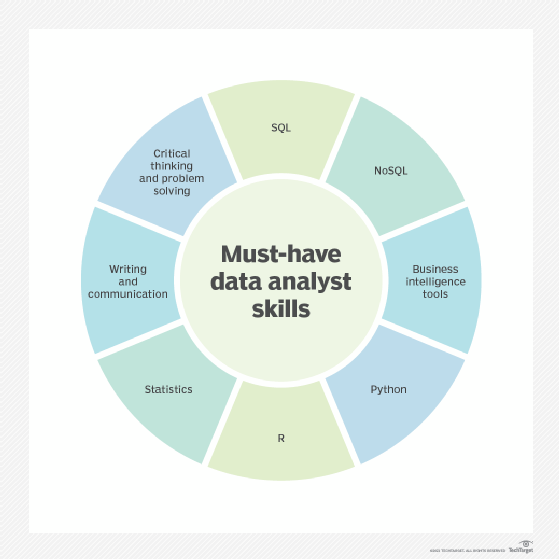
Getty Images
Top 8 must-have data analyst skills for 2021
Knowledge of programming languages, a solid mathematical background and good communication skills are some of the ingredients that go into a well-rounded data analyst.
Data analysts are one of the most in-demand roles at organizations across the U.S.
A data analyst is a professional who specializes in gathering data, analyzing that data for patterns and presenting that data in reports. They are an invaluable asset to organizations that use data to gain insights -- which describes most modern organizations, businesses and governments.
Data analysts can help solve a number of problems. For example, a data analyst working in a healthcare setting might analyze patient data to help identify chronic disease in a patient. And analysts who work for a streaming service provider such as Hulu might derive insights that help the provider refine the presentation of its content.
What are the responsibilities of a data analyst?
Data is created and consumed quickly. Data analysts are responsible for analyzing data as it comes in to help the organization they work for a achieve a goal. Analysts process large quantities of data and put it in terms that a business can understand. Data analysts look at data with a set of questions they need to answer. They then look for patterns in the data that might lead to an answer and present their findings in a report to the organization.
They are also responsible for improving the processes that each of these steps involves, whether it be the established methodology for collecting, analyzing and reporting data, or finding new data sources from which to collect data.
Data analysts are often compared to data scientists. The two work together on the same data sets but take different approaches. While data analysts focus on answering a specific set of questions, data scientists focus on developing new questions to ask. Data scientists tackle long-term problems with research and prediction, whereas data analysts tackle short-term problems to help organizations make tactical decisions. Data scientists also use the reports that analysts create to inform their long-term projects.
Learn more about how data scientists compare to data analysts, and the overlap between the two data-science-oriented roles.

Must-have data analyst skills
Data analysts need a mixture of hard and soft skills to do their jobs effectively, as they are the bridge between the business side of an organization -- which requires soft skills such as communication and teamwork -- and data science -- which requires hard skills such as programming languages and business intelligence software. In other words, analysts interpret data for the people on the business side, so they need both data skills and people skills.
Here are the basic skills a data analyst must have on their resume:
- knowledge of business intelligence tools
- mathematical and statistical knowledge
- computer science and coding knowledge
- communication
- research
- problem solving
- critical thinking
- attention to detail
Below are eight more specific skills that data analysts also need to land a job in the field.
1. Structured Query Language (SQL)
SQL is a programming language used to manage relational databases, and data analysts can use it to run queries on the data within those databases. SQL is better for processing large datasets than other spreadsheet and computing tools, such as Excel.
Most data analyst jobs listings mention knowledge of SQL as a requirement. Besides being an essential skill, SQL is a great introduction to learning programming languages.
2. NoSQL
If data analysts are going to understand SQL, they should also understand NoSQL, as the two are commonly compared database architectures. SQL is a language. NoSQL commonly describes nonrelational databases -- databases that don't use SQL, or databases that don't exclusively use the SQL programming language. NoSQL databases are often preferred for their easy horizontal scalability and flexibility in an organization. They are also preferred for their real-time analysis capabilities and their availability over data consistency.
Learn how "NewSQL" databases attempt to bridge the gap between SQL and NoSQL architectures, by providing the benefits of both in one platform.
3. Business intelligence tools
Business intelligence tools such as Tableau, Power BI, Qlik and Looker are used to make data visualizations. Data visualizations enable nontechnical business personnel to understand the reports that analysts create.
Just as SQL makes data accessible to the data analyst, data visualization makes it accessible to people with little to no knowledge of programming languages or the techniques necessary to navigate a database.
Business intelligence tools enable businesses to make decisions based on data. In this complete guide to BI, learn how BI tools are used.
4. Python
Python is one of the most important programming languages for data analysts to learn. Python comes with many specialized, open source libraries -- many of which pertain to machine learning and artificial intelligence. Though some might consider ML and AI to be more in the ballpark of the data scientist role, they are useful for data analysts as well, and Python is one way to direct the power of AI and ML at big data sets to derive insights from them.
In 2020, the IEEE Spectrum survey rated Python as the top programming language to learn. Although there is more of a learning curve than SQL, Python is still a relatively easy-to-learn programming language. Python is versatile, and can be used in a variety of contexts, not just data analytics.
Because Python is open source and fairly general purpose, it has become popular in academic circles and with hobbyists. There are many available avenues for coders to grow their knowledge, and for beginners to get into Python.
5. R
R is another commonly used programming language in data analytics, and there is often debate over which is more preferable -- Python or R. R is useful for data wrangling, which is the act of preparing data for business intelligence tools. R has several data-centric add-on packages that enables users to visualize data, perform advanced statistical functions and map data geographically. Like Python, R is also free to use and open source.
The difference between the two languages is that R is more directly tailored to data science and analysis, whereas Python is more of a general-purpose language that happens to work well for data analytics due to its expansive collection of libraries. However, both languages are must-haves for a well-rounded data analyst.
6. Statistics
Most data analyst job postings do not require a mastery of statistics, but basic knowledge of some statistical concepts is important to understand -- especially for those working in a data-science-heavy context.
Some basic concepts to understand are significance testing, and linear and logistic regression. These are some of the statistical concepts that form the foundation of machine learning, which powers predictive data analytics. Although a data analyst may not always use in-depth statistics in their work, it is important to know so the analyst can prepare data with some foresight into how the data scientist on their team -- if there is one -- might use the data they've prepared, analyzed and reported on.
Learn more about logistic and linear regression algorithms and the important role they play in predictive analytics.
7. Writing and communication
Data analysts will often work on a bigger data science team, with data scientists and data engineers. They are also responsible for communicating their findings to nontechnical members of their organization. As such, analysts need to be able communicate complex topics in a way that anyone can understand.
For example, if someone can't understand a report, an analyst will have to try explaining it a different way. Good communication also includes good listening skills. Data analysts need to understand what the business really needs and what problems need to be solved before diving into analysis. This requires listening to organization leadership and translating basic business needs into what presents itself in the data.
8. Problem solving and critical thinking
Another necessary soft skill is the ability to problem solve and critically think about all aspects of a business problem. After all, a data analyst's job is to analyze data and translate it into potential solutions to business problems. This goes hand-in-hand with listening and communication. At the end of the day, the data can be analyzed and re-analyzed, but if it doesn't serve a functional purpose to the business, it's not worth much.
Dive deeper into the importance of creative problem solving on a data analytics team, and learn how business leaders continue to seek out data analysts' opinions earlier in the decision-making process.
How to become a data analyst
There is no one path to becoming a data analyst. As companies seek out well-rounded candidates to fill these positions, having a breadth of different learning experiences is important.
Some possible ways to gather the skills necessary include:
- data science career certifications
- university degrees
- self-teaching using massive open online courses
- previous experience with a data science or analytics project
In terms of university degrees, studying something related to math or statistics is a safe bet. This could be a direct degree in statistics or mathematics, or it could be an indirectly related degree that involves statistical training, such as sociology. A degree in computer science is also a good choice. Some universities also offer analytics and data science as specific degrees.
In the actual interview process, it's important to be consistent. For hard skills, it's important that candidates mention skills that they can demonstrate if asked. Candidates should not list SQL if they can't demonstrate how to write an SQL query. For soft skills -- such as communication or problem solving – candidates should be prepared with a story or example of how they applied these traits to a real-world problem.
Self-teaching using data science books is another option for learning data analyst skills. This list of expert-recommended data science books covers beginner-level rudimentary hard skills such as statistics and Python, as well as higher-level data science books that discuss the intersection of data science and big data with societal issues.
Read more on whether a certification or degree program is the right path for you.








